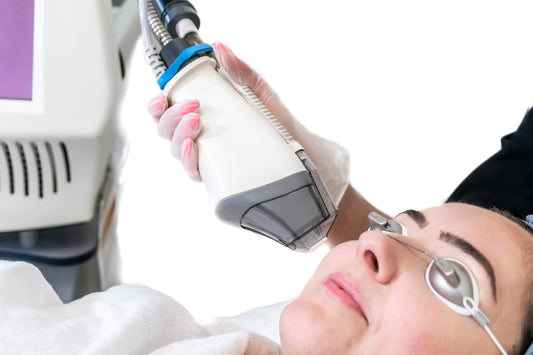Most men have concerns about losing their hair. By your 30s, you’re probably keeping a close eye on your hairline, and like 50 million other men, you may notice your forehead is getting larger or some thinning at your crown.1
A receding hairline is the first sign of androgenetic alopecia or male pattern baldness. Most people think a receding hairline is inherited from your mother. That’s partially true, but it isn’t the whole story. Many factors play a role in your hair’s history, some of which you can control.
Genetics and Hereditary Factors
It’s well known that genes play a role in your receding hairline. The androgen receptor (AR) gene found on your X chromosome inherited from your mother is the culprit in blaming male pattern baldness on your mother. Androgens are male sex hormones and the AR gene determines your sensitivity to them. Men with this gene have twice the risk of losing their hair than men without it.3
However, hair loss involves more than one gene. There are 63 known genes that play a role in hair loss and only six of them are on the X chromosome.3
Additionally, you’re more likely to have hair loss if you are white or have Afro-Caribbean heritage. Studies show that if your father is bald, you’re 2-6 times more likely to lose your hair, and 80 percent of men with male pattern baldness have a father with hair loss.2
Hormonal Changes
Hair has a growth cycle that lasts 2-7 years. Typically after a growth cycle, your hair enters a resting phase for a few months, falls out, and is replaced by new hair.1
Hormone changes can disrupt your hair’s growth cycle. Fluctuations in an sex hormone called dihydrotestosterone (DHT) contribute to hair loss. Too much DHT stimulation can speed up the hair growth cycle and delay regrowth, causing thinning or baldness.1
Aging and Its Effects
Studies show that aging affects hair color, production, and fiber structure. Hair density peaks at age 25 and scalp coverage peaks at age 35. Lipid production, the natural oils that give hair its shine, softness, and smoothness, declines between ages 45-50.4
As you age, your hair may also turn gray, becoming more sensitive to ultraviolet rays (UV) and can degrade the hair fibers, making hair look dull, thin, and frizzy.6
In your 60s, you’re at higher risk for conditions that may cause hair loss. Fifty percent of men over 50 have some type of hair loss.6
Lifestyle and Environmental Factors
Studies show your daily health habits can impact your hair loss.
- Stress: Sudden or long-term physical or emotional stress can cause hair loss, a condition called telogen effluvium. Fortunately, the hair usually grows back once the stressful situation is resolved.1
- Smoking: Smoking can speed up hair loss by reducing the blood flow to the hair follicles. Smokers are twice as likely to have gray hair, which also can cause hair breakage.1
- Sleep: A disturbed sleep cycle can disrupt a gene that keeps your skin moisturized, causing a dry, itchy scalp and weakening the hair follicle’s root.8
- Obesity: While there isn’t a direct link between obesity and hair loss, obesity increases your risk for several inflammatory conditions, including skin diseases that can impact hair health.8
- Diet: Your hair gets nutrients from the food you eat. It's important to get enough healthy proteins, vitamins, minerals, and fats. A diet rich in these can help you keep your hair strong and healthy.8
- Sun exposure: Those highlights you get from being in the sun are actually weakened hair strands.UV rays can negatively impact your hair’s ability to absorb proteins and hold color.8
Medical Conditions and Medications
Some medical conditions or their treatments can affect hair growth.
- Thyroid Disorders: Your thyroid is found in the front of your neck and produces hormones that help regulate many of your body’s functions. Severe or untreated thyroid disorders, including hypothyroidism or hyperthyroidism, almost always have associated hair loss. Fortunately, once the condition is controlled, the hair typically regrows.11
- Autoimmune diseases: Alopecia areata is an autoimmune disease that causes your immune system to attack hair follicles, causing you to lose hair from your head, eyebrows, or eyelashes, and is triggered by other autoimmune diseases, such as psoriasis, vitiligo, and thyroid diseases. Studies also indicate that people with asthma, hay fever, and atopic dermatitis have a higher risk of alopecia areata.10
- Medications: Certain chemotherapy medications are known to cause hair loss, but they are not the only cause of drug-induced hair loss. Other drugs that can cause hair loss include:
- Antifungals
- Antiseizure drugs
- Antidepressants
- Beta-blockers
- Blood thinners
- Cholesterol drugs
- Thyroid drugs
- Steroids
- Hormone replacement therapy.3
Typically hair regrows once medication is stopped but you shouldn’t stop treatment without discussing the pros and cons with your doctor.
Hair Care Practices
The way you treat, style, and care for your hair can play a role in your hair health.
Tight hairstyles like braids or cornrows might result in traction alopecia or hair loss caused by tight pulling on the follicles. Excessive brushing can also be hard on hair.4
Hot oil treatments or chemical perms and straighteners can reduce hair density and diameter, causing breakage. These can also cause scalp scarring which means permanent hair loss.6
Hair dying and bleaching can also weaken the hair follicles, leading to breakage.7
UnTangled Essentials Kit
• Engineered to work in tandem
• Visibly fuller hair in 90 days
Preventative Measures and Treatments
Whatever the cause of your receding hairline, you can take actions to prevent or slow its progress.
First, to prevent hair loss and keep hair healthy
- Shampoo and moisturize your hair regularly.
- Eat a healthy diet and protect your hair from exposure to sun and severe cold.
- Treat any nutritional deficiencies and medical conditions. Essential hair growth vitamins and minerals that may help include biotin or vitamin B7, vitamins D, E, C, A, zinc, iron, and selenium.7
Foundation Skincare’s Hair Serum stimulates hair growth at the follicle root and can make hair look fuller and thicker. Paired with UnTangled Hair Supplement, a hair supplement with the vitamins, minerals, herbs, and acids you need to revitalize stagnant hair growth, can help your hair stay healthy and regrow. If you are concerned with hair loss, medical experts recommend taking two capsules a day to start and tapering to one capsule to maintain hair volume.
You can talk to your doctor about preventive medications like minoxidil. These typically work while they are being used but hair loss resumes when you stop taking them.
A receding hairline, while common, isn’t a foregone conclusion. Taking care of your hair and consulting your doctor about the cause of your hair loss can help you understand the best way to prevent or treat your hair loss.
References:
-
https://www.medicalnewstoday.com/articles/320537
-
https://my.clevelandclinic.org/health/diseases/24515-male-pattern-baldness-androgenic-alopecia
-
https://www.healthline.com/health/baldness-gene#genetics-of-balding
-
https://www.mayoclinic.org/diseases-conditions/hair-loss/symptoms-causes/syc-20372926
-
https://www.ncbi.nlm.nih.gov/pmc/articles/PMC6369639/
-
https://www.ncbi.nlm.nih.gov/pmc/articles/PMC10075351/
-
https://health.clevelandclinic.org/your-guide-to-aging-hair
-
https://www.ncbi.nlm.nih.gov/pmc/articles/PMC8835065/
-
https://www.healthline.com/health/thyroid-and-hair-loss#connection
-
https://www.aad.org/public/diseases/hair-loss/types/alopecia/causes
-
https://www.btf-thyroid.org/hair-loss-and-thyroid-disorders
-
https://www.ncbi.nlm.nih.gov/books/NBK279388/
-
https://www.mayoclinic.org/diseases-conditions/hair-loss/symptoms-causes/syc-20372926






